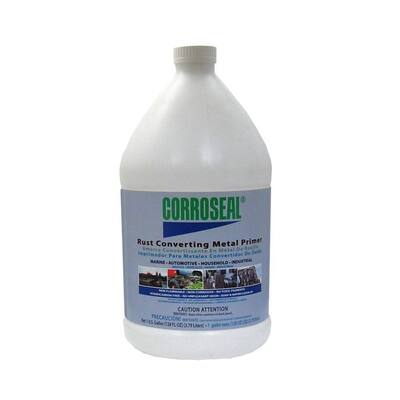
Corroseal is the rust converter and sealer that Steve and I are using on the rusty areas of the trailer. We decided to start with the roof since we noticed a leak in the tack room. We need to get that repaired before we can continue on with the rest of the trailer. It makes sense to do this "top down" approach anyways, why do work inside just to have it destroyed by leakage from outside?
All areas had already been brushed with wire brushes or sanded with a sander to remove any loose material. You want a clean, tight rusted area in order to apply the Corroseal. We started with the 4 seams on the roof and then the seam that each roof piece creates as it attaches to the sides of the trailer.
You want a nice thick coat of 8-10mils thick. Within about 5 minutes the surface will start to turn black as the rust is converted to magnetite. If not, while it's still tacky you just need to apply more Corroseal to enable the reaction.
It was pretty neat to see the crumbly rust turn into a smoother and hard material. Corroseal is much thinner than I had thought it would be. At first my hubby and I were a little grumpy about this but then realized that all the nooks and crannies where rust starts forming would have made it hard for a thicker substance to work. While I worked on the rusty front of the trailer Steve worked on the right of the trailer pulling out caulking and scraping seams.
One thing I noticed with Corroseal is that even if you put several coats over rusty areas, the stained paint will still be stained a rust color, that's not going to go away until you apply your final paint. That's essentially because the stain is not really rust so the converter doesn't work on the stain. It was frustrating at first since I kept reapplying Corroseal to areas and it never turned black. It was the stained paint not rust. The Corroseal works great on the actual rust but is supposed to etch the paint which will in turn help the topcoat adhere better.
After working on the front of the trailer I worked on the back of the trailer just behind the wheels. This flat area always collects water and had some heavier rust developed. Steve removed the caulking. I then brushed it out and cleaned the surface for Corroseal application.
In every seam this trailer has rust. I think most of the caulking on the outside was the original caulking from 1995!! Caulking is something that should be checked regularly and removed when it no longer forms a tight seal. I will keep Corroseal on hand for any future rust that develops but hopefully I can just touch up paint nicks before any exposure to water occurs! It amazes me that all the steel trailers I see have rust, it's pretty simple to keep at it and keep that steel protected!
Alright, I'm done with ranting on the subject of trailer maintenance. It's so satisfying to watch that rust turn hard and black!!! On the other side of the trailer in the same "behind the wheels location" there is a small hole that we'll have to Bondo. It's not in an area of concern but still, it was extremely satisfying to watch it solidify and blacken. We'll have to smooth it out before the final paint job of course. There are also dozens of holes drilled into the steel that were from holding roof racks or fence panels. These holes are a little rusty so once treated with Corroseal we'll Bondo them closed since we won't need those screw holes anymore.
It's great seeing some progress on this trailer restoration! Next step will be to fully seal the roof seams and apply Mobile Coat to the entire roof surface. More on that in the next trailer post....









No comments:
Post a Comment